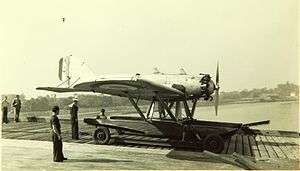Gourdou-Leseurre GL-832 HY
The Gourdou-Leseurre GL-832 HY was a 1930s French light shipboard reconnaissance floatplane design and built by Gourdou-Leseurre for the French Navy.
| GL-832 HY | |
|---|---|
 | |
| Role | Shipboard reconnaissance floatplane |
| Manufacturer | Gourdou-Leseurre |
| First flight | 1931 |
| Introduction | 1934 |
| Retired | 1941 |
| Primary user | French Navy |
| Produced | 1934–1936 |
| Number built | 22 |
Development
In 1930 the French Navy issued a requirement for a light coastal patrol seaplane mainly for use in the French colonies. Gourdou-Leseurre built and designed a prototype GL-831 HY which was a modification of the companies earlier GL-830 HY with a smaller Hispano-Suiza radial engine. The GL-831 HY first flew on 23 December 1931. In 1933 the French Navy ordered 22 aircraft designated GL-832 HY, this had a less powerful engine than the prototype. The GL-832 HY was a metal construction low-wing monoplane with fabric covered wings and twin floats. The aircraft had a large wing to take the stresses of a catapult launch, the wings also folded to allow stowage on board a ship. Unusually the braced-horizontal tailplane was attached to the underside of the rear fuselage. Two open cockpits in tandem were provided for the two crew, each cockpit having a windscreen. The first production aircraft flew on 17 December 1934 and the last on 12 February 1936.
Operational history
The French Navy used the GL-832 HY on second-line cruisers like the Emile Bertin and Primauguet and on smaller colonial sloops. The smaller sloops did not have a catapult and the aircraft were lowered into the sea using a crane. The aircraft were still operational at the start of the Second World War and were not retired until 1941.
Variants
- GL-830 HY
- Prototype with one 350hp (261 kW) Hispano-Suiza 9Qdr radial engine, one built.
- GL-831 HY
- Prototype with one 250 hp (186 kW) Hispano-Suiza 9Qa radial engine, one built.
- GL-832 HY
- Production version with one 230 hp (171 kW) Hispano-Suiza 9Qb radial engine, 22 built.
Specifications (GL-832 HY)
Data from The Illustrated Encyclopedia of Aircraft (Part Work 1982–1985), 1985, Orbis Publishing, Page 1994
General characteristics
- Crew: Two
- Length: 8.74 m (28 ft 8 in)
- Wingspan: 13 m (42 ft 7.75 in)
- Height: 3.48 m (11 ft 5 in)
- Wing area: 29.50 m2 (317.55 sq ft)
- Empty weight: 1,108 kg (2,443 lb)
- Gross weight: 1,696 kg (3,739 lb)
- Powerplant: 1 × Hispano-Suiza 9Qb 9-cylinder radial piston engine , 172 kW (230 hp)
Performance
- Maximum speed: 196 km/h (122 mph, 106 kn)
- Range: 590 km (367 mi, 319 nmi)
- Service ceiling: 5,000 m (16,405 ft)
Armament
- 1 7.7mm (0.303 in) Vickers machine-gun on a flexible-mounting
References
| Wikimedia Commons has media related to Gourdou-Leseurre GL-832 HY. |
- The Illustrated Encyclopedia of Aircraft (Part Work 1982–1985), 1985, Orbis Publishing, Page 1994